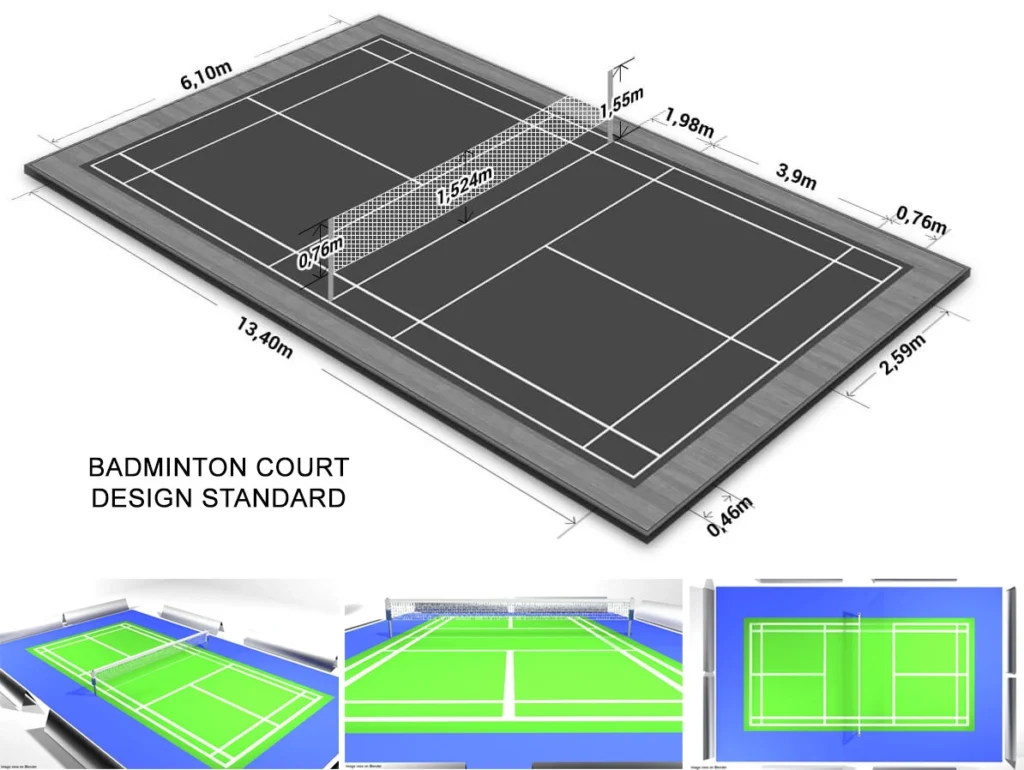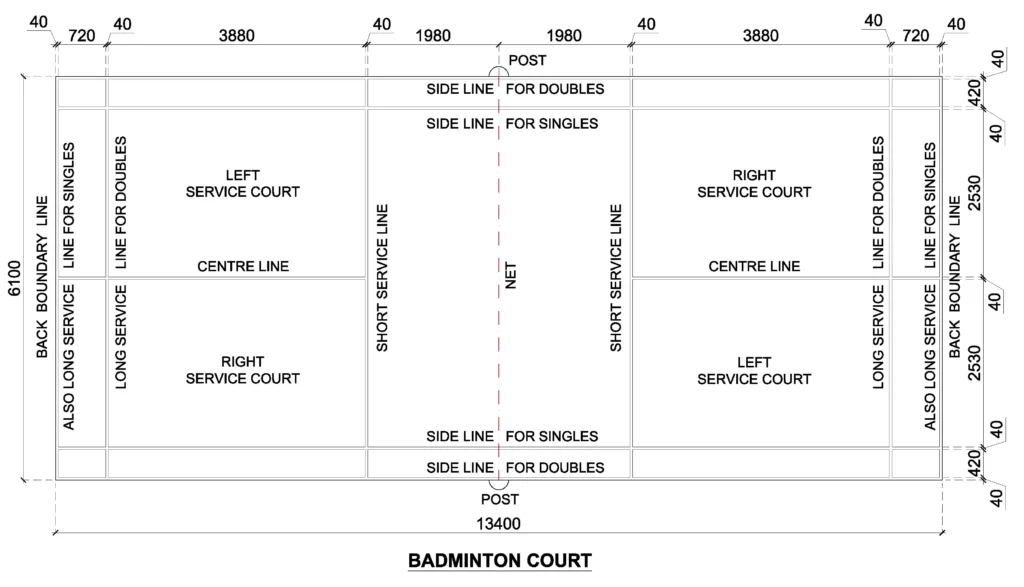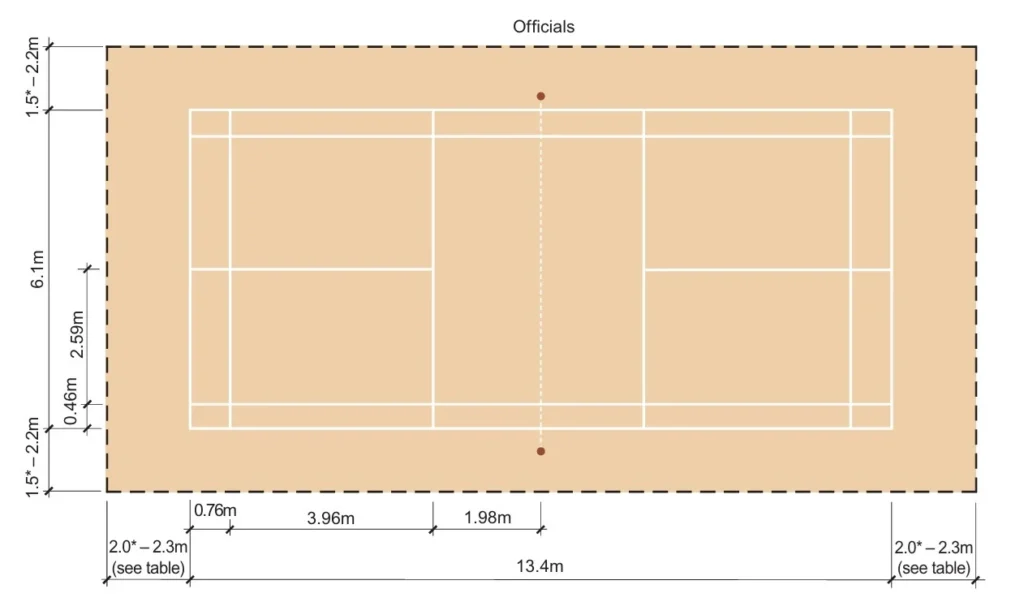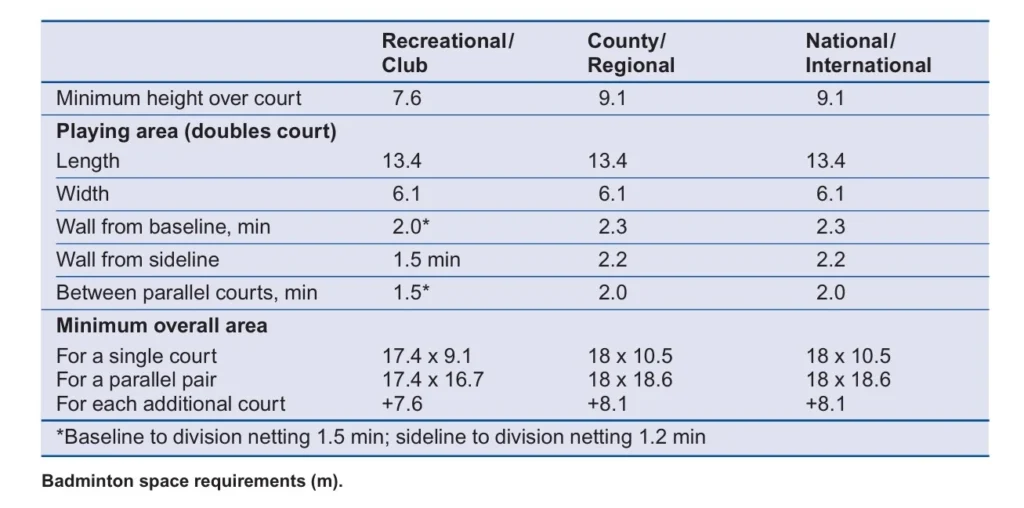Badminton has a long history, tracing its roots to ancient games played in India and China. The modern version of badminton evolved from a game called “Poona,” which was played in India during the 19th century. British officers stationed in India brought the game back to England, where it gained popularity. In 1873, the Duke of Beaufort introduced the game at his estate in Badminton, Gloucestershire, which led to its modern name.

Initially, badminton courts were informal, with varying dimensions. However, as the sport gained popularity, standardized court dimensions were introduced. The Badminton World Federation (BWF) established official court measurements to ensure uniformity and fair play, which are now used globally in both recreational and professional matches.
If you want to know about the Types of slabs or Permeable concrete or Islamic architecture, please click the link.
1) Badminton court and court equipment

- The court shall be a rectangle marked out with lines 40 mm wide as shown in Diagram above.
- The lines marking out the court shall be easily distinguishable and preferably be coloured white or yellow.
- All the lines shall form part of the area which they define.
- The posts shall be 1.55 metres in height from the surface of the court and shall remain vertical when the net is strained
- The posts shall be placed on the doubles side lines as in Diagram above irrespective of whether singles or doubles is being played. The posts or its supports shall not extend into the court beyond the side lines.
- The net shall be made of fine cord of dark colour and even thickness with a mesh of not less than 15 mm and not more than 20 mm.
- The net shall be 760 mm in depth and at least 6.1 metres wide.
- The top of the net shall be edged with a 75 mm white tape doubled over a cord or cable running through the tape. This tape shall rest upon the cord or cable.
- The cord or cable shall be stretched firmly, flush with the top of the posts.
- The top of the net from the surface of the court shall be 1.524 metres at the centre of the court and 1.55 metres over the side lines for doubles.
- There shall be no gaps between the ends of the net and the posts. If necessary, the full depth of the net at the ends shall be tied to the posts.
2) Competition Venue
i) Field of Play
The floor of the field of play must measure not less than 46 metres by 30 metres.
The uninterrupted height above the floor must be not less than 12 metres..
ii) Flooring
The surface on which carpeting and court mats are placed must be a wooden, sprung floor.
iii) Court Equipment
Court mats, posts and nets for three competition courts and three warm-up courts must be procured only from sources authorised by the BWF.
iv) Lighting
The positioning and lux requirements of lighting over the field of play may vary according to the nature and structure of the competition hall. Lighting must be situated at least one metre outside, and at least 12 metres above, the court boundaries.
There should be no direct glare from lighting into the eyes of players on court. A lighting level of at least 1200 lux is required on the court, for intended TV camera shots. Court lighting must be capable of immediate response to the on/off switch.
There must be no external sources of light through windows etc. Lighting over spectator areas must be capable of being dimmed during play.
v) Background
The walls or any material covering the walls, ‘A’ boards and other interior surrounds (including seating) to the field of play must be of a dark colour. Light colours – white or yellow, for example – must not be used.
[Note: according to lighting placements and the height of the ceiling above the lighting, it may also be inappropriate for the ceiling to be of alight colour].
vi) Air movement
The field of play must have minimal draughts or other air movement. Where air-conditioning is normally used, special attention must be paid to its effects. Double-door (airlock) entry/exit points must be provided.
vii) Warm-up area
This must be close to the competition hall and accessible under cover. Space for three courts is required. An uninterrupted height above the courts of at least 10 metres must be provided. .
viii) Coach videoing
Physical provision must be made for team coaches to video matches involving their players, as is generally allowed at all BWF events. These videos are for private use and analysis only, and users can, if desired, be required to sign appropriate commitments as to use
3) Specifications for international standard facilities
i) Major BWF tournaments
The minimum height from the floor over the full court for the Olympic Games, the World Championships, the World Senior Championships, shall be 12 meters (39 feet).
The required height shall be entirely free of girders and other obstructions over the area of the court.
ii) Other BWF and international events
The desirable height for all other international play is 12 meters (39 feet), but the minimum height is 9 meters (30 feet).
The required height shall be entirely free of girders and other obstructions over the area of the court.
iii) Flooring
It is desirable to have a wooden sprung floor together with approved non-slip court mats.
It is recommended that there shall be at least two meters (6½ feet) clear space surrounding all the outer lines of the court, this space also being a minimum requirement between any two courts marked out side by side.
iv) Background and lighting
To avoid any difficulty in sighting the shuttle, no part of the background behind the ends of the court should be coloured white. It is desirable that only darker colours are used.
The minimum recommended lighting level is 1000 Lux to provide even light over the court area. [Note, TV will advise on their lighting requirements and the optimal conditions for still photographers are 1800-2000 Lux].
Lighting should not be directly over or behind the playing area but be positioned along the sides of the court.
All sources of daylight or sunlight behind or along the sides of the court, should be eliminated.
v) Air movement
Any air movement e.g. draughts from air conditioning must be tightly controlled or eliminated
4) Specifications of flooring for badminton court for SAI centres
For BWF, World and Official Competitions, only a wooden or synthetic surface is allowed. Any surface must be previously approved by the BWF, Badminton is an indoor game. For Indoor surfaces provide
- Maple/Teak wood Flooring with the flooring system and manufacturer approved by BWF in SAI Centres where National camps are held or Elite trainees train
- At all other locations provided Synthetic Polyurethane flooring with flooring system and manufacturer approved by BWF
Note: In all areas which are termite infested only Synthetic Polyurethane flooring with flooring system and manufacturer approved by FIBA shall be provided
i) Dimensions
Dimensions/Details as indicated under club/county/Regional in the figure below shall be followed by all Regional Centre /Academic Institution.
At all other locations provide dimensions/details indicated under ‘Recreational’ Dimensions/Details indicated under National/International category shall be provided only if the court is proposed to hold National/International competition with spectator facilities

